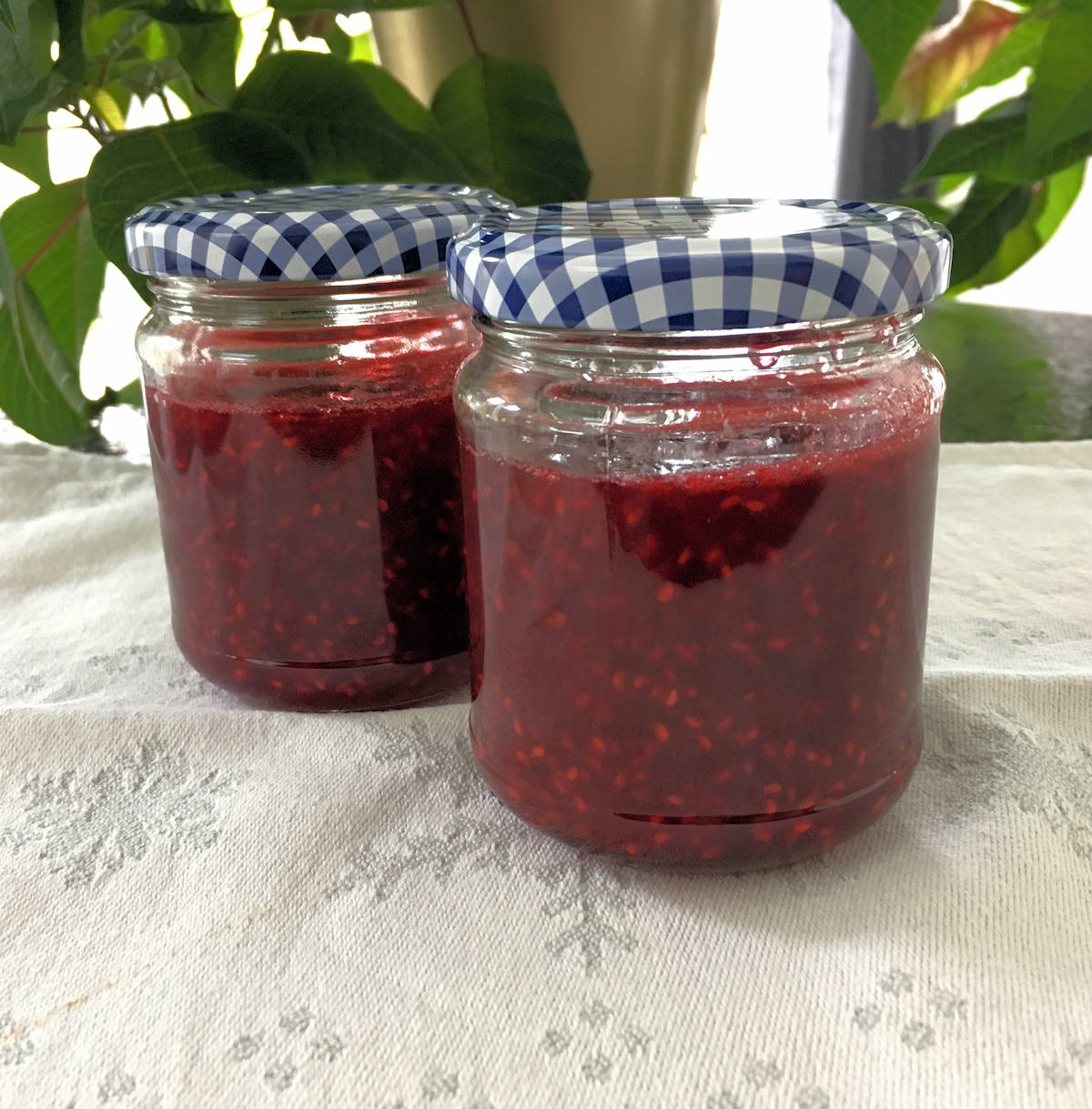Homemade raspberry jam is the best, but this recipe is suited for any berry jam. Preserving sugar helps it set thanks to pectins in it, but you can make it with ordinary sugar too - just cook it a bit longer.

We're jamming!
I used to think that for homemade jam you needed tonnes and tonnes of fruit and it took hours and hours of boiling the stuff in huge vats, with purple splatter and sticky gunk all around.
That’s a complete myth: you need about 300g of raspberries to make a jam size jar of jam, that will last through the winter. And we all know raspberry jam is the best.
Berry malicious
If you have a few raspberry canes in the garden, you’re lucky! Or unlucky? The annoying thing about berries is that they don’t all ripen at the same time.
They will tauntingly deliver a handful of gorgeous fruit on a daily basis, which of course you can do nothing with but eat on the spot. But unless you own a whole raspberry plot, that daily fruit drip is all you will get!
An amount for a cake might be achievable if you’re very restrained and store the berries over three or four days in the fridge, in an airtight container. But jamming amounts are not really feasible.
Pick Your Own farms are your salvation, since raspberries sold in supermarkets are ridiculously expensive. A trip to the PYO farm will result in at least a couple of punnets, which means you are in business.
No sugar, no jam
Jams originated as a method to preserve fruit for autumn and winter, and sugar is one of the best preserving agents.
It works by the magic of osmosis: added to fresh foods, it removes moisture from their cells, thus making it hard for bacteria and other nasties to get in. Bacteria need water to grow and multiply, so lowering the water activity in a food product means there are fewer free water molecules for the bacteria.
Which means that marzipan made with raw eggs is safe to eat even for the biggest food safety alarmists.
So what about those jars of ‘sugar free’ jams in speciality shops and supermarkets?
It’s a con. Okay – I won’t simplify or rant but explain: you can cook down fruit on its own and it might be delicious, but it won’t keep.
Commercially produced sugar free jams use all kinds of substitutes that, frankly, sound disgusting. Flaxseeds, chia seeds or starch (i.e. corn, potato or tapioca) are commonly used to achieve a jammy consistency while the sweetness is provided by artificial sweeteners of which the less said, the better.
Like I said: no sugar, no jam.
How to make raspberry jam
The proportions are similar for all kinds of fruit, except oranges for marmalade which I know nothing about: about the same weight of fruit and sugar.
If you use ordinary sugar instead of preserving sugar which has powdered pectin added, make sure you squeeze at least half a lemon in. Acid, somehow counterintuitively, helps jams set. Also counterintuitively, less ripe fruit has higher pectin content so don’t throw those paler, skankier berries away.
Don’t wash the fruit unless it’s absolutely necessary. Additional water will have to be cooked off so the time it takes to the setting point will be longer.
The time it takes is controversial. Some recipe writers like Delia Smith think jam is ready in half an hour. I’ve found it takes longer than expected.
You can shorten the time though by warming up the sugar in the oven, spread on a baking tray. It is handy also for sterilising your jar by placing them in that oven to bake clean.
Raspberries in a pot will need to be warmed through to their breaking point, about fifteen minutes while the sugar heats up.
With a lot of care and oven gloves or tea towels, add the hot sugar to the mix and stir thoroughly. That should shorten the cooking time to about fifteen-twenty minutes. But to make sure, test that it’s ready.
How to recognise when jam’s ready?
Best with a jam thermometer. Jam setting temperature is 105C / 221F.
Note however that it takes absolute ages to get from about 102C to 105C, so don’t jump the gun too early. Make sure the temperature is reached, or it will be too runny. Unless you like runny.
The other method is the frozen plate trick: drop a blob of the jam onto a plate that has been kept in the freezer. Wait a minute and prod it: if it feels set, it’s done.
You can add a knoblet of butter to the jam in the pot at the very end which will make the jam shinier and get rid of the sugar scum on the surface. Then, decant into sterilised jars with utmost care and a jam funnel.
Seedless jam
You must be joking. Are you five?
More jam recipes
Apple marmalade, thick and gorgeous spiced apple preserve with natural pectin. If it’s never jam today, perhaps we can have some marmalade, eh?
Cherry jam recipe. Like all jams, making cherry jam is easy and you can cook a small quantity with ordinary sugar. My cherry jam recipe has a secret ingredient that enhances the flavour.
Peach jam with a hint of vanilla, easy to make and very flavoursome. Roughly chopped peaches with skins make wonderfully chunky jam.
More raspberry recipes
Raspberry and almond slice, a gorgeous buttery traybake with flaked almond, sugar and butter topping: it’s easier to make and tastier than Bakewell!
Raspberry crumble bars with oats, brown sugar and fresh berries; recipe adapted from the New York 'Baked' bakery cookbook.
No churn raspberry ripple ice cream, based on Nigella Lawson’s recipe: stupidly easy, and amazingly effective. Two ingredients plus raspberry puree equals ice cream made in ten minutes.